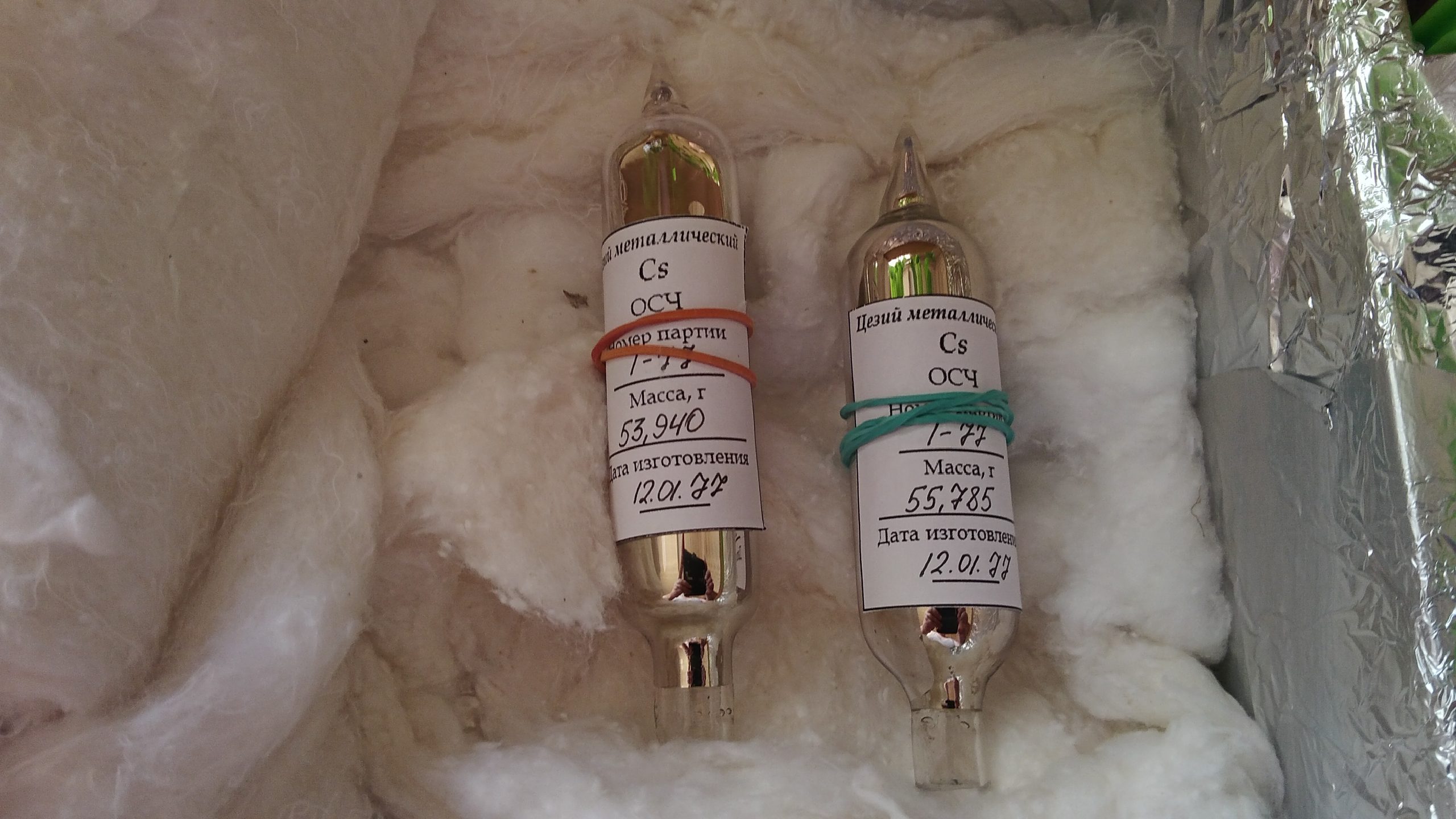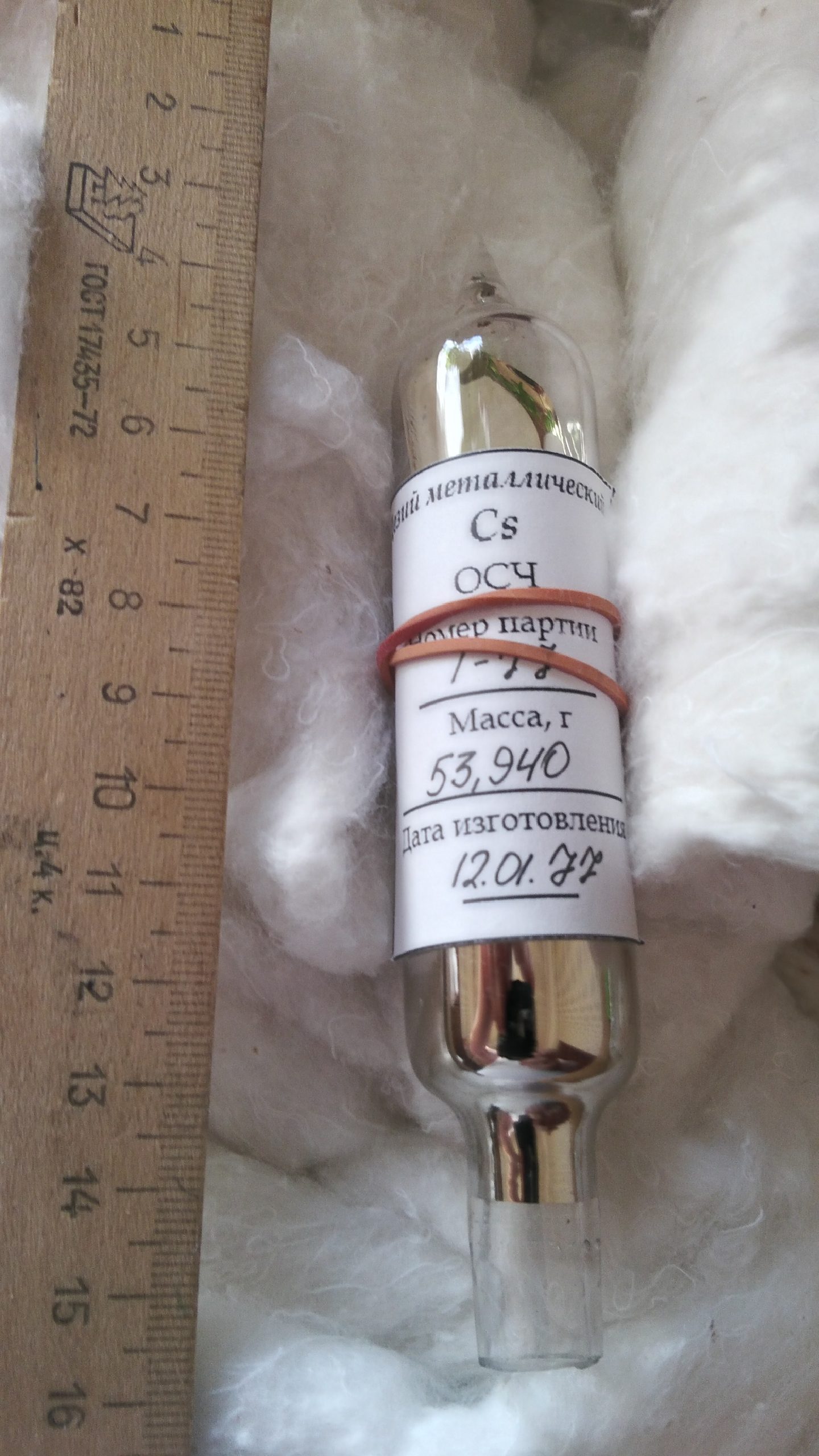Cesium 133 - Cs133
It took 44.200 liters of mineral water from Bad Dürkheim to detect the heavy alkali metal cesium for the first time. In the dry residue of this mineral water, Robert Wilhelm Bunsen and Gustav Robert Kirchhoff discovered the specific spectral lines in 1861. Cesium was the first element to be identified using modern spectroscopic methods. Rubidium and indium followed shortly afterwards. The names of all three elements allude to the colors of the most intense bands in the atomic emission spectrum: cesium compounds glow sky blue in the flame. Kirchhoff and Bunsen made a series of cesium compounds and characterized the metal as the most electropositive of all known elements. In principle, they succeeded in melt-flow electrolysis of the chloride, but the metal began to form in a finely divided form, and the melt turned "smalt blue" - an effect that has been described several times for colloidal cesium. The first gram-scale production of cesium was achieved by Carl Setterberg, who in 1 subjected a mixture of cesium cyanide and barium cyanide to melt flow electrolysis in Bunsen's laboratory. [1881] Pollucite, (Na1-xCsx)2Al2Si4O12· H2O, from which CsCl is produced, which is reduced with calcium in the heat. The cesium metal is distilled off in vacuo and, after several purification steps by distillation, it is melted under protective gas in glass ampoules.
Cesium metal has a golden metallic luster, even though many sources still write today that it is silver in its pure form, and only oxidic impurities provided the golden color. The golden color comes from relativistic effects. When viewed under normal pressure, cesium vapor appears moss green, both effects are also known from gold. With dry oxygen, cesium reacts immediately and covers with a black scale layer if the addition is not slow and with stirring. This is very cumbersome in the preparation of clean samples of cesium-oxygen compounds from the elements, because it greatly impedes the further reaction. If there are traces of moisture in the protective gas, the metal quickly coats with a thin layer of its hydroxide, immediately loses its golden sheen and then shimmers silver. This loss of color is extremely sensitive and noticeable. It may be the reason for the color, which is frequently described incorrectly.
The chemistry of cesium with oxygen is unique: no other metal offers such a colorful abundance of binary compounds, whereby the simple oxide Cs of all things2O is particularly rare to see. The suboxides [3] Cs7O (bronze colored), Cs4O (metallic red violet), Cs11O3 (metallic blue-violet) and “Cs3O “(black with a blue-green sheen) are hermaphrodites made of metals and ion crystals. The orange oxide Cs2O is produced by using the suboxide Cs3O thermal to Cs + Cs2O decomposes and the excess cesium is distilled off. The colorless peroxide Cs2O2 can be obtained from the hyperoxide by controlled thermal decomposition or by reaction from the elements in liquid ammonia. If cesium metal is reacted with an excess of oxygen, a black, heterogeneous product mixture is initially obtained. Long-term annealing in an oxygen atmosphere finally gives the canary-yellow hyperoxide CsO2.
This can then continue with ozone to the dark red ozonide CsO3 be implemented. Last but not least, there is also a black double salt, the peroxide-hyperoxide Cs4O6, known. In terms of redox chemistry, cesium is more exciting than you should expect for the most electropositive of all elements. If you heat Cs2O, it disproportionates into metallic cesium and CsO2, This is an oxidation of the oxidation to the hyperoxidion, whereby the oxidizing agent Cs+ is reduced to Cs metal. A reduction of cesium is also possible: With suitable cryptands and solvents, cesium metal can be converted into a Cs at low temperatures+Cation complexed by the cryptand and a solvated Cs-- Disproportionate anion. In the meantime, a whole series of such alkali and electride is known. [4]
Cesium and Chernobyl
Only the stable isotope occurs in nature 133Cs before. However, since the Chernobyl nuclear disaster in 1986, large parts of the population have found the element cesium in the form of the radioactive fission product 137Cs became known, which came to a large extent in the environment. The isotope has a half-life of 30,17 years and, since cesium is readily water-soluble, it reaches the food chain from the soil above all via fungi and plants and is still responsible for a large proportion of the background radioactivity. The rare metal is physiologically irrelevant. In the body it is similar to potassium and can replace it. This means that when it is incorporated, it is involved in essential physiological processes, but is also excreted very quickly.
Cesium and its applications
The uses of the expensive metal are limited. In the vast majority of cases (reducing agent, cooling medium, ...) it can be replaced by cheaper alkali metals. Larger amounts of cesium chloride are used as drilling lubricants in oil production, otherwise small amounts are used as getter metal in vacuum tubes, as an ultracentrifuge medium or in camouflage ammunition. A few atoms are sufficient for the most famous application in the cesium atomic clock. 137Cs has found a niche existence as a tracer element in geophysics and radiation therapy, and some thermionic batteries and food irradiation systems are also based on this isotope. The binding energy of the 6s electron in cesium is so low that infrared light of 910 nm is sufficient to produce the photoelectric effect. [5] The work functions are even lower for the metal-rich oxygen compounds, the suboxides of cesium. And these are unique to cesium. Therefore, the first night vision devices had a silver layer as a photo cathode, which is so thin that it shines through in blue. This was coated with cesium and cesium oxide, which resulted in the formation of cesium suboxides. Modern residual light amplifiers use semiconductor materials, cesium has been completely displaced from this area.
Cesium - the high price and smuggling
The high price of cesium is an obstacle for many chemists to use this element to a greater extent in syntheses. The price for cesium is currently around 40 euros per gram, roughly on the level of the gold price, with larger quantities showing significantly lower prices than small quantities. The actual price depends more on the ampoule size than on the purity. If you want, you can even do isotope-pure 133Buy Cs for 1.000 euros per gram, which is particularly interesting when you consider that natural cesium is inherently isotope-pure. The easiest way, however, is to buy cesium cheaply from customs or the criminal police. For some time now, there has been constant smuggling of excellently prepared material from Eastern Europe and Russia. The material was produced in the 1970s and 1980s, probably in connection with Soviet projects on magnetohydrodynamic (MHD) generators. A plasma is shot through between two conductive electrodes. A magnetic field is applied perpendicular to the electrodes, which spatially separates the differently charged ions. The resulting voltage difference can therefore directly convert kinetic energy into electrical energy. The first MHD generator with 11,5 kW was built in the USA in 1959, an MHD pilot power plant with 25 MW output went into operation in the Soviet Union in 1971, a 1985 MW power plant was planned in Ryazan for 500, and other large power plants were to be used nationwide consequences. The first systems used the hot combustion gases from conventional power plants as operating plasma, but a plasma circuit could be used in so-called closed MHD generators. [6] Cesium is ideally suited as an operating medium: it can be easily ionized, already has a high vapor pressure at moderate temperatures and transports a lot of kinetic energy due to its high atomic weight. In addition, the refractive index in gaseous cesium is <1, which is advantageous for the plasma dynamics. The large-scale projects were abandoned in the course of the collapse of the Eastern Bloc, the cesium that was available became unemployed and finally began its way west. Either the cesium is confiscated during transport to the inner-European borders, or it is seized in "bunker finds". [7] It is not surprising that, after briefly studying the relevant substance data and safety data sheets, the responsible authorities are generally happy to find competent buyers for the often several kilograms of cesium. A number of German research groups are therefore grateful to organized smuggling for the constant and selfless support of their work.
Selected Literature
- G. Kirchhoff, R. Bunsen, Ann. physics Chem. 1861, 189, 337.
- C. Setterberg, Liebigs Ann. Chem. 1881, 221, 100.
- A. Simon, Z. Anorg. Gen. Chem. 1973, 395, 301.
- RH Huang, DL Ward, ME Kuchenmeister, JL Dye, J. Am. Chem. Soc. 1987, 109, 5561.
- R. Schulze, Z. Phys. 1934, 92, 212.
- "Flame in the tunnel", Der Spiegel 1988, 38.
- First chief police officer of the Heilbronn police headquarters, personal communication.
Text with slight changes taken from:
https://faszinatio nchemie.de/wissen-und-ffekten/news/caesium-das-unedle-gold/
Source:
Many thanks to Dr. High.

Priv. Lecturer Dr. Constantin Hoch
LMU Munich, Department of Chemistry
Images: ISE


